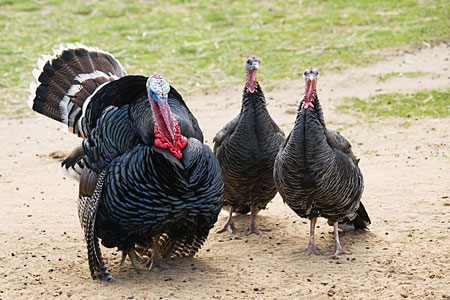
What is the best turkey mating ratio for good fertility? That’s a question many first-time turkey keepers ask. Often as not, they get many different answers. Here’s why:
Turkey Type
The first thing to consider is the type of turkeys in question. If they are a broad-breasted type, forget it. These industrial size turkeys are designed to produce lots of meat. As a result of their enormous weight and outsize breasts, they are too awkward to mate naturally. Breeding broad breasted turkeys requires artificial insemination.
Heritage turkeys, on the other hand, reproduce through natural mating. In fact, that’s one of the defining characteristics of heritage poultry. So discussing a turkey mating ratio implies heritage turkeys.
Turkey Age
The next consideration is how old the turkeys are. A young tom or an aging tom is not as virile as a mature, healthy tom and therefore can’t effectively breed as many hens.
How old is old enough? Turkeys that hatch in spring are mature enough to mate as yearlings the following spring. Turkeys that hatch in the fall typically won’t be ready to breed until their second spring, at about a year and a half.
Mating Ratio
An appropriate turkey mating ratio is important because having too few or too many toms can result in low fertility. For a small flock, keeping too many toms is more common than having too few.
Too many toms can be hard on the hens and cause serious injuries. Even just two toms in a flock may interfere with each other’s attempt to mate, reducing fertility.
So let’s look at some numbers. The Livestock Conservancy suggests that a suitable mating ratio for a yearling or aging tom is between 8 and 14 hens to one tom, while the mating ratio for a mature tom would be between 14 and 20 to one.
The Livestock Conservancy further breaks down this ratio by body type — the smaller the turkeys are, the more hens a healthy tom can handle. Thus 20:1 applies to a small turkey like Royal Palm, while 15:1 is more appropriate for a large turkey like the standard Bronze. Mid-size breeds fall in between at 18:1.
Many backyard breeders prefer a smaller turkey flock. A ratio frequently quoted by highly successful breeders is 10:1. Cackle Hatchery® recommends 7:1.
Plenty of backyarders don’t keep even that many turkeys, and get excellent fertility at 5:1. But fewer hens than that can result in overbreeding.
Breeding Plan
The idea of achieving the perfect mating ratio is to experience good fertility without excessive breeding. However, toms being toms, overbreeding can occur regardless of the mating ratio.
One fix for overbreeding is to use turkey breeding saddles. Another is to house the tom separately, allowing only occasional conjugal visits.
An excellent plan is to do both — protect hens from injury by applying saddles during the tom’s visit. No need to house a tom with the hens full time, since a turkey hen will produce fertile eggs for at least 3 weeks after natural mating.
Indepth Info
Differences between Heritage Turkeys and Broad Breasted Turkeys, Cackle Hatchery
Selecting Your Best Turkeys for Breeding, The Livestock Breeds Conservancy
Breeding Principles and Practices, Chapter 5, Turkey Management, Cornell University Library
Duration of Fertility and Hatchability Following Natural Matings in Turkeys, Elsevier
And that’s today’s news from the Cackle Coop.
Gail Damerow contributed the chapter on keeping turkeys in The Backyard Homestead Guide to Raising Farm Animals.

